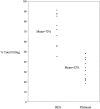Aneurysm packing with HydroCoil Embolic System versus platinum coils: initial clinical experience
- PMID: 14729529
- PMCID: PMC7974178
Aneurysm packing with HydroCoil Embolic System versus platinum coils: initial clinical experience
Abstract
The HydroCoil Embolic System (HES; MicroVention, Aliso Viejo, CA) was developed to improve the efficacy of endovascular treatment of cerebral aneurysms. The HES may reduce recurrences of aneurysms by allowing for increased packing density as compared with platinum coils. We report our initial experience with the HES in the treatment of 11 patients with cerebral aneurysms and compare findings to those in size-matched control cases treated with platinum coils. The HES provided substantially improved volumetric packing of the aneurysm lumen relative to standard platinum coils (73% vs. 32%; P=.0001).
Figures


References
-
- Cognard C, Weill A, Spelle L, et al. Long-term angiographic follow-up of 169 intracranial berry aneurysms occluded with detachable coils. Radiology 1999;212:348–356 - PubMed
-
- Debrun GM, Aletich VA, Kehrli P, et al. Selection of cerebral aneurysms for treatment using Guglielmi detachable coils: the preliminary University of Illinois at Chicago experience. Neurosurgery 1998;43:1281–1295 - PubMed
-
- Kuether TA, Nesbit GM, Barnwell SL. Clinical and angiographic outcomes, with treatment data, for patients with cerebral aneurysms treated with Guglielmi detachable coils: a single-center experience. Neurosurgery 1998;43:1016–1025 - PubMed
-
- Satoh K, Matsubara S, Hodoh H, Nagahiro S. Intracranial aneurysm embolization using interlocking detachable coils: correlation between volume embolization and coil compaction. Intervent Neuroradiol 1997;3:125–129 - PubMed
Publication types
MeSH terms
Substances
LinkOut - more resources
Full Text Sources
Other Literature Sources
Medical
